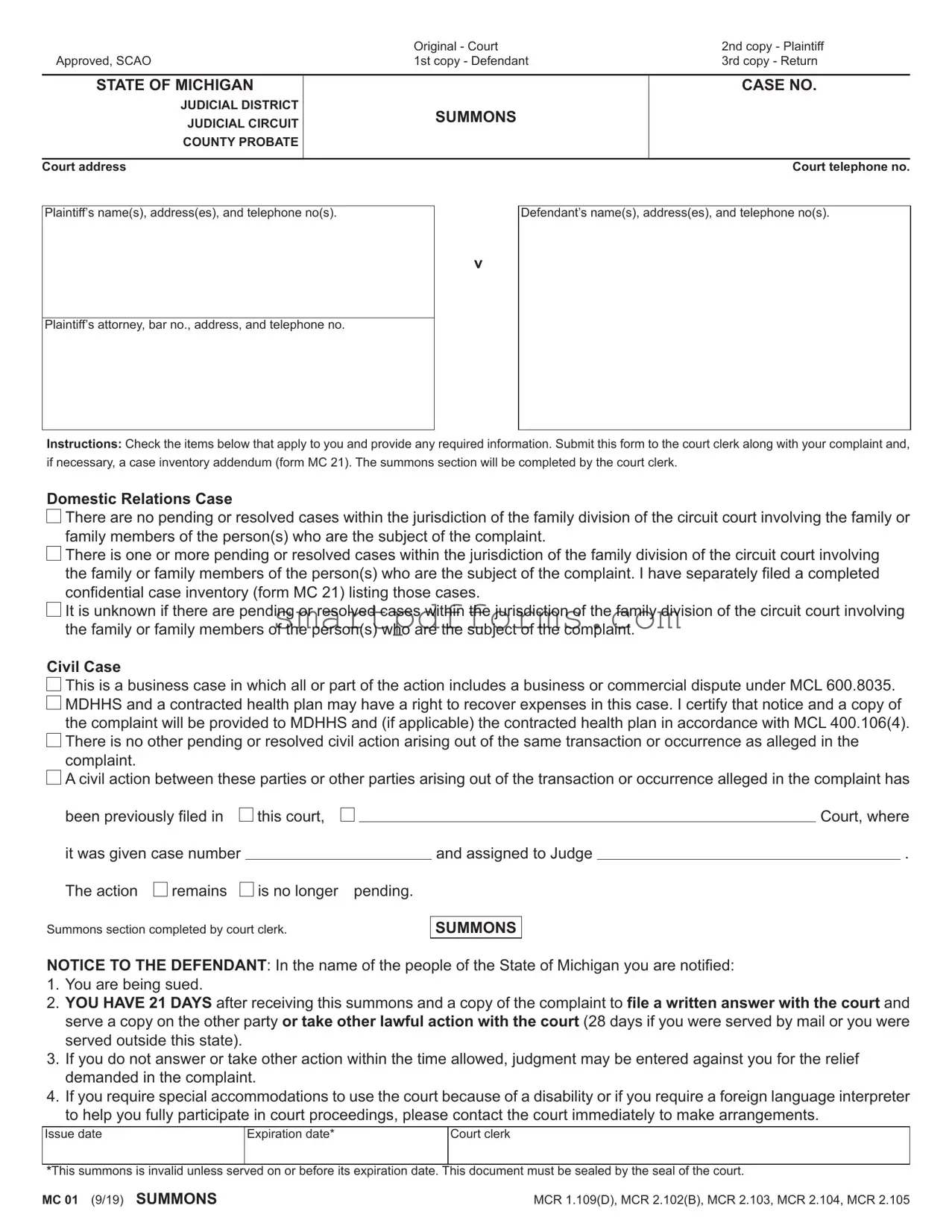|
Original - Court |
2nd copy - Plaintiff |
Approved, SCAO |
1st copy - Defendant |
3rd copy - Return |
STATE OF MICHIGAN |
|
CASE NO. |
JUDICIAL DISTRICT |
SUMMONS |
|
JUDICIAL CIRCUIT |
|
|
|
COUNTY PROBATE |
|
|
|
|
|
Court address |
|
Court telephone no. |
Plaintiff’s name(s), address(es), and telephone no(s).
Defendant’s name(s), address(es), and telephone no(s).
v
Plaintiff’s attorney, bar no., address, and telephone no.
Instructions: Check the items below that apply to you and provide any required information. Submit this form to the court clerk along with your complaint and, if necessary, a case inventory addendum (form MC 21). The summons section will be completed by the court clerk.
Domestic Relations Case

 There are no pending or resolved cases within the jurisdiction of the family division of the circuit court involving the family or family members of the person(s) who are the subject of the complaint.
There are no pending or resolved cases within the jurisdiction of the family division of the circuit court involving the family or family members of the person(s) who are the subject of the complaint.

 There is one or more pending or resolved cases within the jurisdiction of the family division of the circuit court involving the family or family members of the person(s) who are the subject of the complaint. I have separately filed a completed confidential case inventory (form MC 21) listing those cases.
There is one or more pending or resolved cases within the jurisdiction of the family division of the circuit court involving the family or family members of the person(s) who are the subject of the complaint. I have separately filed a completed confidential case inventory (form MC 21) listing those cases.

 It is unknown if there are pending or resolved cases within the jurisdiction of the family division of the circuit court involving the family or family members of the person(s) who are the subject of the complaint.
It is unknown if there are pending or resolved cases within the jurisdiction of the family division of the circuit court involving the family or family members of the person(s) who are the subject of the complaint.
Civil Case

 This is a business case in which all or part of the action includes a business or commercial dispute under MCL 600.8035.
This is a business case in which all or part of the action includes a business or commercial dispute under MCL 600.8035.

 MDHHS and a contracted health plan may have a right to recover expenses in this case. I certify that notice and a copy of the complaint will be provided to MDHHS and (if applicable) the contracted health plan in accordance with MCL 400.106(4).
MDHHS and a contracted health plan may have a right to recover expenses in this case. I certify that notice and a copy of the complaint will be provided to MDHHS and (if applicable) the contracted health plan in accordance with MCL 400.106(4).

 There is no other pending or resolved civil action arising out of the same transaction or occurrence as alleged in the complaint.
There is no other pending or resolved civil action arising out of the same transaction or occurrence as alleged in the complaint.

 A civil action between these parties or other parties arising out of the transaction or occurrence alleged in the complaint has
A civil action between these parties or other parties arising out of the transaction or occurrence alleged in the complaint has
been previously filed in |
this court, |
it was given case number |
|
The action |
remains |
is no longer pending. |
Summons section completed by court clerk.
NOTICE TO THE DEFENDANT: In the name of the people of the State of Michigan you are notified:
1.You are being sued.
2.YOU HAVE 21 DAYS after receiving this summons and a copy of the complaint to file a written answer with the court and serve a copy on the other party or take other lawful action with the court (28 days if you were served by mail or you were served outside this state).
3.If you do not answer or take other action within the time allowed, judgment may be entered against you for the relief demanded in the complaint.
4.If you require special accommodations to use the court because of a disability or if you require a foreign language interpreter to help you fully participate in court proceedings, please contact the court immediately to make arrangements.
*This summons is invalid unless served on or before its expiration date. This document must be sealed by the seal of the court.
MC 01 (9/19) SUMMONS |
MCR 1.109(D), MCR 2.102(B), MCR 2.103, MCR 2.104, MCR 2.105 |

TO PROCESS SERVER: You are to serve the summons and complaint not later than 91 days from the date of filing or the date of expiration on the order for second summons. You must make and file your return with the court clerk. If you are unable to complete service you must return this original and all copies to the court clerk.
CERTIFICATE / AFFIDAVIT OF SERVICE / NONSERVICE
OFFICER CERTIFICATE |
OR |
AFFIDAVIT OF PROCESS SERVER |
I certify that I am a sheriff, deputy sheriff, bailiff, appointed |
|
Being first duly sworn, I state that I am a legally competent |
court officer, or attorney for a party (MCR 2.104[A][2]), |
|
adult, and I am not a party or an officer of a corporate |
and that: (notarization not required) |
|
party (MCR 2.103[A]), and that: (notarization required) |
|
|
|

 I served personally a copy of the summons and complaint,
I served personally a copy of the summons and complaint,

 I served by registered or certified mail (copy of return receipt attached) a copy of the summons and complaint,
I served by registered or certified mail (copy of return receipt attached) a copy of the summons and complaint,
together with
List all documents served with the summons and complaint
on the defendant(s):
Complete address(es) of service

 I have personally attempted to serve the summons and complaint, together with any attachments, on the following defendant(s) and have been unable to complete service.
I have personally attempted to serve the summons and complaint, together with any attachments, on the following defendant(s) and have been unable to complete service.
Complete address(es) of service
I declare under the penalties of perjury that this proof of service has been examined by me and that its contents are true to the best of my information, knowledge, and belief.
Service fee |
Miles traveled |
Fee |
|
$ |
|
|
|
|
$ |
|
|
|
|
|
Incorrect address fee |
Miles traveled |
Fee |
TOTAL FEE |
$ |
|
|
$ |
|
$ |
|
|
|
|
Signature
Name (type or print)
Title
|
|
|
|
|
|
|
|
|
|
Subscribed and sworn to before me on |
|
|
, |
|
|
County, Michigan. |
|
Date |
|
|
|
|
|
|
My commission expires: |
Signature: |
|
|
Date |
|
Deputy court clerk/Notary public |
|
Notary public, State of Michigan, County of |
|
|
|
|
|
|
|
ACKNOWLEDGMENT OF SERVICE
I acknowledge that I have received service of the summons and complaint, together with
Attachments
on
Day, date, time



 There are no pending or resolved cases within the jurisdiction of the family division of the circuit court involving the family or family members of the person(s) who are the subject of the complaint.
There are no pending or resolved cases within the jurisdiction of the family division of the circuit court involving the family or family members of the person(s) who are the subject of the complaint.
 There is one or more pending or resolved cases within the jurisdiction of the family division of the circuit court involving the family or family members of the person(s) who are the subject of the complaint. I have separately filed a completed confidential case inventory (form MC 21) listing those cases.
There is one or more pending or resolved cases within the jurisdiction of the family division of the circuit court involving the family or family members of the person(s) who are the subject of the complaint. I have separately filed a completed confidential case inventory (form MC 21) listing those cases.
 It is unknown if there are pending or resolved cases within the jurisdiction of the family division of the circuit court involving the family or family members of the person(s) who are the subject of the complaint.
It is unknown if there are pending or resolved cases within the jurisdiction of the family division of the circuit court involving the family or family members of the person(s) who are the subject of the complaint.
 This is a business case in which all or part of the action includes a business or commercial dispute under MCL 600.8035.
This is a business case in which all or part of the action includes a business or commercial dispute under MCL 600.8035.
 MDHHS and a contracted health plan may have a right to recover expenses in this case. I certify that notice and a copy of the complaint will be provided to MDHHS and (if applicable) the contracted health plan in accordance with MCL 400.106(4).
MDHHS and a contracted health plan may have a right to recover expenses in this case. I certify that notice and a copy of the complaint will be provided to MDHHS and (if applicable) the contracted health plan in accordance with MCL 400.106(4).
 There is no other pending or resolved civil action arising out of the same transaction or occurrence as alleged in the complaint.
There is no other pending or resolved civil action arising out of the same transaction or occurrence as alleged in the complaint.
 A civil action between these parties or other parties arising out of the transaction or occurrence alleged in the complaint has
A civil action between these parties or other parties arising out of the transaction or occurrence alleged in the complaint has

 I served personally a copy of the summons and complaint,
I served personally a copy of the summons and complaint,
 I served by registered or certified mail (copy of return receipt attached) a copy of the summons and complaint,
I served by registered or certified mail (copy of return receipt attached) a copy of the summons and complaint,
 I have personally attempted to serve the summons and complaint, together with any attachments, on the following defendant(s) and have been unable to complete service.
I have personally attempted to serve the summons and complaint, together with any attachments, on the following defendant(s) and have been unable to complete service.